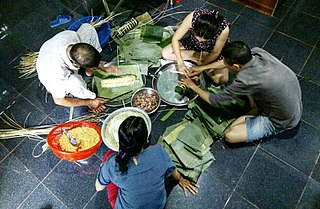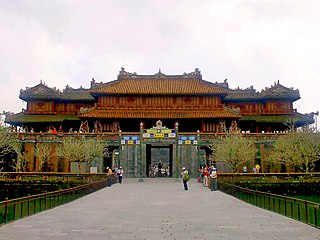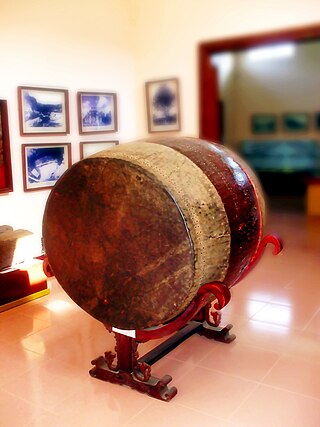
Tết, short for Tết Nguyên Đán, is the most important celebration in Vietnamese culture. Tết celebrates the arrival of spring based on the Vietnamese calendar, which is mostly based on the lunisolar Chinese calendar and usually has the date in January or February in the Gregorian calendar.

Traditional Vietnamese music encompasses a large umbrella of Vietnamese music from antiquity to present times, and can also encompass multiple groups, such as those from Vietnam's ethnic minority tribes.
Articles related to Vietnam and Vietnamese culture include:

The culture of Vietnam are the customs and traditions of the Kinh people and the other ethnic groups of Vietnam. Vietnam is part of Southeast Asia and the Sinosphere due to the influence of Chinese culture on Vietnamese culture.

Đặng Hữu Phúc is a Vietnamese pianist and composer best known for his film scores. A graduate of the Hanoi Conservatory, he has penned over 60 works, primarily for film and theatre.

Vietnamese clothing is the traditional style of clothing worn in Vietnam by the Vietnamese people. The traditional style has both indigenous and foreign elements due to the diverse cultural exchanges during the history of Vietnam. This all eventually led to the birth of a distinctive Vietnamese style of clothing, including the birth of the unofficial national dress of Vietnam, the áo dài.

Nhã nhạc is a traditional music of Vietnam. Vietnamese court music is very diverse, but the term nhã nhạc refers specifically to the Vietnamese court music performed from the Trần dynasty of the 13th century to the Nguyễn dynasty at the end of the 20th century.

Theatre of Vietnam comprises many traditional forms of drama which survive and retain their popularity to varying degrees. It formed during the Đinh dynasty, when the Đại Cồ Việt state was born. Water puppetry is a distinctively Vietnamese art form which arose in the 12th century in which a split-bamboo screen obscures puppeteers, who stand in water manipulating the puppets in front of the screen using long poles. Water puppetry is currently popular with tourists to Vietnam. With the success of the August Revolution in 1945, theatrical art entered a new creative period including a new type of theater based on the music of local folk tunes.

Vietnamese art is visual art that, whether ancient or modern, originated in or is practiced in Vietnam or by Vietnamese artists.

Vũ Minh Sơn was a Vietnamese singer. He was also the son of singers Minh Cảnh and Kiều My. By the age of six he started performing and singing traditional Vietnamese Cải lương music and Vietnamese pop songs under the stage name Cảnh Sơn. Sơn travelled throughout the country with a group of famous singers and comedians such as Siu Black, Thanh Lam, Quang Linh, Minh Thuận, Duy Ngọc, Duy Phương, Hương Loan, Ngọc Thành and his sister Kiều Nhi, and became well-known for performing covers of "Lòng mẹ" (Ngọc Sơn) and "Còn thương rau đắng mọc sau hè" (Bắc Sơn).

Đăng đàn cung was the royal anthem of the Nguyễn dynasty, Vietnam.
Quang Lê is one of the top selling Vietnamese-American recording artists, renowned for his unique covers of many traditional Vietnamese songs created and written before, during and about the Vietnam War. Quang Lê has become a household name within the Vietnamese music industry worldwide, from the United States, to Canada, to France, to the United Kingdom, to Germany, to the Czech Republic, to Australia and back home in Vietnam. Quang Lê achieved success at a young age, with hits such as “Sương Trắng Miền Quê Ngoại”, “Đập Vỡ Cây Đàn”, “Đường Về Quê Hương” and “Tương Tư Nàng Ca Sĩ”. Many famous Vietnamese songwriters, such as Đinh Miên Vũ, personally write songs for Quang Lê to perform on the Thúy Nga Paris By Night stage.

Ngũ Cung is a Vietnamese progressive rock band formed in 2007. They were well known for their winning in the talent contest Rock Your Passion in 2007. After Rock Your Passion contest, Ngũ Cung also has become a phenomenon in Vietnam for their exceptional music which is a fusion of rock and traditional rhythm from the Northwest of Vietnam. In 2008, their song 'Cướp Vợ' won the Impressive Composition Prize at Bai Hat Viet Competition.

Vietnamese architecture is the architectural style used in Vietnam through the process of historical development and the absorption and integration of regional and international architectures. Vietnamese architecture is reflected in the works from đình, shrines, temples, nhà thờ họ, citadels, palaces and housing architecture.

The trống cái or trống đại "great drum" is a traditional Vietnamese bass drum. It has a barrel-shaped wooden body, and gives a deep booming sound. The trong cai drums are typically hung on a stable frame, and in traditional drama the trống đại cổ is beaten to support the singers. It can also be carried and used at the head of a dragon dance procession.

The House of Nguyễn Phúc, also known as the House of Nguyễn Phước, was a ruling family of Vietnam. It ruled from the city of Huế in central Vietnam beginning in 1636. As the Nguyễn lords, they often fought with the Trịnh lords, who were based in Hanoi. They were overthrown by the Tây Sơn dynasty in 1776.

The Esplanade of Sacrifice to the Heaven and Earth is an imperial altar situated south of the city of Huế, central Vietnam. It also known as the Nam Giao altar. It is dedicated to the heaven and earth. The complex was visited by the monarchs of the Nguyễn dynasty for annual ceremonies of prayer to Heaven.

Khăn vấn, khăn đóng or khăn xếp, is a kind of turban worn by Vietnamese people which had been popular since Nguyễn dynasty. The word vấn means coil around. The word khăn means cloth, towel or scarf.

The seals of the Nguyễn dynasty can refer to a collection of seals specifically made for the emperors of the Nguyễn dynasty, who reigned over Vietnam between the years 1802 and 1945, or to seals produced during this period in Vietnamese history in general.
















